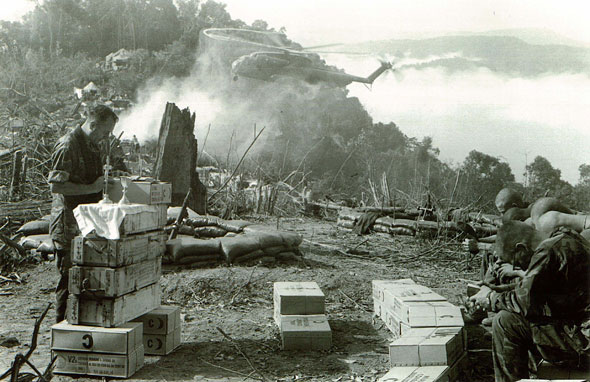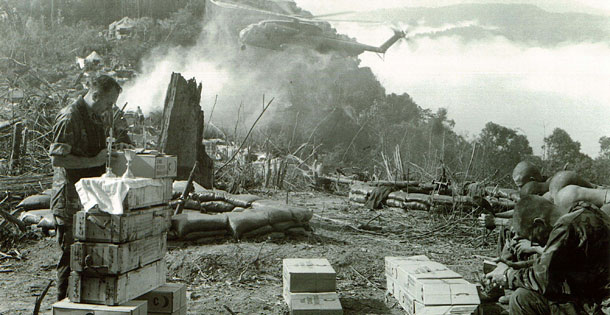Andy Vaart remembers seeing the photo of our friend and fellow Marine Lee Roy Herron as “the most unforgettable moment” of his life. It was March 1969:
“I had finished class that afternoon and returned to my apartment,” Vaart recalls. “There, I opened my latest copy of the Navy Times. As I leafed through it I happened on a photograph. … The picture showed a small group of Marines in a prayer service, men sitting on boxes before a chaplain on a denuded hilltop with a helicopter unloading ammunition in the background. I recognized Lee immediately, sitting in the picture’s foreground. As I marveled at the photograph, the telephone rang.”
On the other end was a Marine officer calling from Texas, telling Vaart that Lee Roy Herron — the friend he had just recognized in the Navy Times — was dead, killed in battle on February 22. The officer was calling on behalf of Lee’s wife, Danelle, to request that Vaart accompany Lee’s body to Lubbock for burial.
Years later Vaart would speak about the photo at a memorial ceremony honoring Herron: “In my experience, never has a photograph captured the spirituality of men at war as well as this one. That Lee should last be photographed in that way speaks more about him than I could possibly offer.”
I first saw the photograph in 2000.
Lee Roy Herron and I met in junior high school in Lubbock, Texas, and remained buddies through college. In 1966, we both attended Marine officer training in Quantico, Virginia. When we received our commissions, I chose the Marine Corps law program. Lee chose the infantry and was sent to Vietnam.
But there was something unusual about the picture. According to the Navy Times, the photograph of Lee was taken on January 26, 1969, at Fire Base Razor. But I knew Lee had been stationed at Fire Base Shiloh.

I first saw the photograph in 2000. But there was something unusual about the picture. According to the Navy Times, the photograph of Lee Roy Herron (head bowed in prayer, far right) was taken at Fire Base Razor. But I knew Lee had been stationed at Fire Base Shiloh.
Colonel Fox offered one possible explanation: Perhaps Lee Roy voluntarily traveled over 10 kilometers of enemy territory just to attend a church service. (Photo by Marine Pfc C.E. Sickler Jr. first appeared in the Navy Times March 5, 1969)
Looking for answers, I sent a copy of the photo to retired Marine Colonel and Medal of Honor recipient Wesley Fox. He had been Lee’s company commander in Vietnam and had written the citation for Lee Roy’s posthumous Navy Cross.
Like me, Colonel Fox was unable to identify the location. Also, he didn’t recognize the chaplain in the photo. Whoever was standing by the altar was not the chaplain assigned to his battalion. But he had no trouble recognizing Lee Roy. He wrote:
David, I got the picture loud and clear. That is Lee in prayer, the scene is at battalion, as that is an 81 mortar set up in the pit. The beaten area looks like the A Shau Valley and Op Dewey Canyon, but that high ground behind does not fit.I cannot place this unless it is the Khe Sanh area right after Christmas. But then, Lee didn’t let distance keep him from his touch with God.
This could be with another battalion as our 1/9 [First Battalion, Ninth Marines] chaplain quit as we stepped off in the attack. We went the entire operation without the man of God.
I found more details about the chaplain and Lt. Herron in Fox’s 2011 book, Six Essential Elements of Leadership:
As our battalion crossed the line of departure in our movement forward on Operation Dewey Canyon in the A Shau Valley, our battalion chaplain had declared himself a heat casualty. Before we left our first night position, and very convenient for him, he walked to our helicopter landing zone to catch the next bird out. He had told our battalion commander that he could not continue with the operation, that he was overcome by heat. (Maybe, it was a warm night, and sleeping does use some energy, but the days surely got hotter for the rest of us.) My rifle company was last off the hill, and we walked by that chaplain standing with his head down in the landing zone as our battalion moved into our attack.
Lee always brought up the rear of my company during our movements while I was at the front, so I wasn’t with him as he passed that chaplain on the landing zone. But I know it hit him hard to see a man of the cloth quit on us. One-nine went in the attack without our official chaplain, but we had a man of the Lord with us. Lee assumed the responsibility on his own and went above and beyond the call of duty to arrange and hold spiritual meetings. He assured that counseling was available to all Marines who wanted it.
Lee’s dedication to his Marines continued into combat, which is reflected in his Navy Cross citation:
Aware that the fire from two mutually supporting hostile machine guns was holding his Marines in place and preventing the removal of the casualties, he completely disregarded his own safety as he exposed himself to North Vietnamese fire to direct a light antitank assault round which scored a direct hit on one of the machine gun bunkers. Boldly leaping to his feet, he fearlessly charged across the fire-swept terrain to hurl hand grenades and fire his weapon against the enemy emplacement, killing nine North Vietnamese soldiers who were in the bunker. While directing his men in the assault on the remaining bunker, First Lieutenant Herron was mortally wounded.
During our conversation, Colonel Fox offered one possible explanation of the photo: Perhaps on that Sunday morning in 1969, Lee Roy flagged down a helicopter going from Shiloh to Razor and voluntarily traveled over 10 kilometers of enemy territory just to attend a church service.
For information that would confirm the colonel’s theory, I enlisted the assistance of then commandant of the Marine Corps, General James L. Jones in July 2000. Within a few weeks, Gen. Jones sent me an original copy of the photo, made from the January 26, 1969, negative in the Library of Congress.
On the back of the photo, along with a note of the location (Fire Support Base Razor) was the name of the chaplain, Salvatore Rubino, who was assigned to the Razor artillery unit, Second Battalion of the 12th Marine Regiment — not the 1/9 chaplain as I had suspected.
I was able to locate Chaplain Rubino, who had retired as a Navy captain. Rubino searched his old letters and found one he had sent to his wife on the day the photo was taken:
We landed at Fire Base Razor yesterday at 1600. This fire base is high on a mountain at approximately 2,000 feet and is located in the A Shau Valley. This fire base, as all the others, was created by an initial bombing from the air, followed by tractors (which were flown in by helicopter) which smoothed the mountain top to accommodate our 105 mm artillery pieces, mortars, ammunition, C-rations, water and personnel. As always, 2/12 supports the 9th Marine Regiment.
This morning I conducted religious services at Fire Base ‘Razor’ and offered communion to the 9th Regiment Headquarters. A photographer was there to take a picture during the service. I think the paper was The Sea Tiger, published by the Fleet Amphibious Force. I am not sure whether the pictures he took will ever be published.
In his letter to me, Chaplain Rubino provided additional background:
The picture itself speaks thousands of words. There was the utter desolation and destruction all around. There was the noise. Often, even during worship services, firepower was called in and the guns would roar. We were tired, and some were more exhausted than others. I recall that just before I served communion, a helicopter approached to deliver ammunition. The wind generated by the rotor was so strong that I had to cover the chalice with my hands to keep it from flying away. I was even afraid that the alter—made up of five C-ration boxes and four ammo-boxes — would bite the dust.
Chaplain Rubino went on to say that he did not recall Lee specifically. That made perfect sense, since Lee was not assigned to Razor. However, he did have a recollection of one Marine attending that day’s service.
That day, the men seated on those C-ration boxes with their heads bowed, transformed that place into hallowed ground — a cathedral in the middle of nowhere. As the men received communion I saw tears touching their cheeks as they worshipped God. One Marine, whose glasses I vividly remember, had dropped to the dusty ground because of the helicopter, came to me at the end of the service, shook my hand, and said from the bottom of his heart, ‘Thank you, Chaplain, for bringing God to such an ungodly place.’ If that Marine was indeed Lee Roy I am certain that God knows it.
Recently I had the opportunity to visit the National Museum of the Marine Corps in Quantico, Virginia. While touring the section of the museum dedicated to the Vietnam War, I noticed a wall devoted to honoring Navy chaplains who served in Vietnam. The top photograph on that wall was the one taken on January 26, 1969 — the same one that includes Chaplain Rubino and my buddy Lee Roy Herron. What a fitting tribute to have that photo displayed perpetually in a prominent museum.
Become a Saturday Evening Post member and enjoy unlimited access. Subscribe now




Comments
I just met Salvatore, a few minutes ago. You can tell he is a man of God that loved serving the USA and loves God!
God bless the brave chaplain that were sure enough of their God to stay with the Marines and perform their services throughout this difficult time. I still say prayers for the chaplains that I knew during my service.
Semper Fi, One never knows until you through that pack on your back; and hump into death.
Thank you for this most inspiring article. Rev. Mr. Steven J. Murphy. Archdiocese of Boston.
Thank you for this wonderful article! Fr. O’Donnell, thank you for your service, Sir! I have enjoyed reading about the Chaplains in Vietnam, and Chaplain Capodanno is one of my favorite Chaplains to read about. Mr. Farrell, I’m sorry if your experience has been one where the field is devoid of Chaplain presence. I always make it a point to go to the field with my Marines, to go on humps with my Marines, and to deploy with them. Hopefully you will have a better experience in the future.
Mr. Farrell. I am not sure of the meaning of your comment, but it seems to say that there were no Chaplains in the field in Vietnam. Sir, you could not be more wrong. Probably the two best known were Congressional Medal of Honor recipients Vincent Cappadanno and Vincent Litecky. My own service while attached to an Amphibious ship (USS TRIPOLI-LPH 10), included caring for the afloat USMC Batallion, four other ships, and the 150 bed hospital in TRIPOLI.
I was in the field 4-5 days a week, having as many as seven services in one day. I often flew between units, but also trudged through the jungle, scared to death, I might add. Only once was I the specific target of a poorly trained (thankfully) North Vietnamese sniper. I owe my life to his poor training and an alert Gunny who tackled me to the ground. I think there always will be chaplains, because there will always be war, sadly.
NO WAY-THE CHAPLAINS COME TO YOU IN THE FIELD
A very touching story. Well Done.